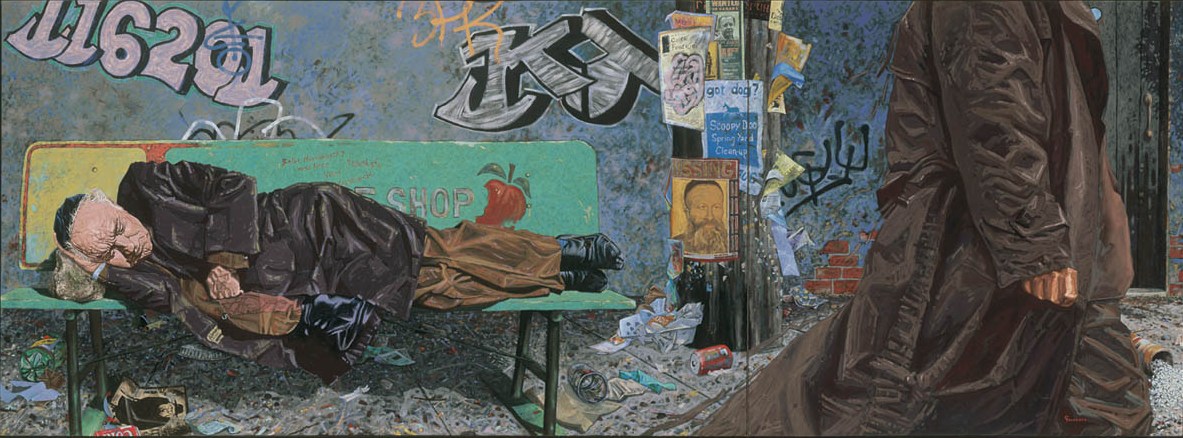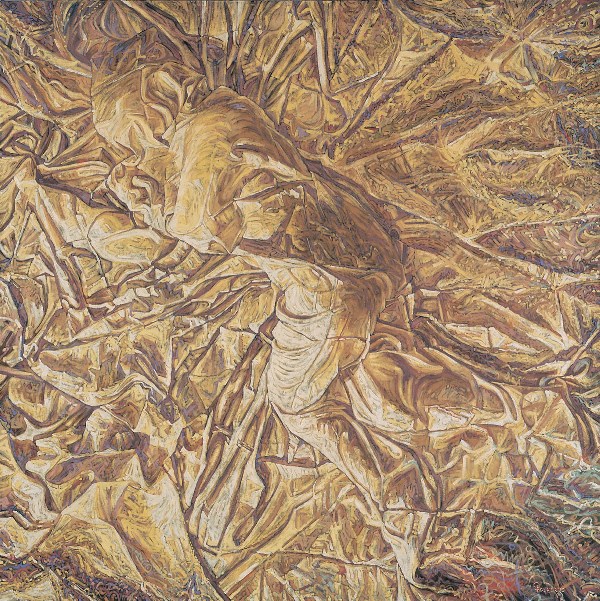Artists


Folkerts, Gerald - VM - Gerald Folkerts
Gerald Folkerts (1958-2009): No Time to Sleep and Waiting for Eternity

Not Sleeping Well?
by Gerald Folkerts
I first met Rabbi Weizman when I tagged along on a field trip with my daughter’s grade six to the B’nai Abraham synagogue in Winnipeg. He showed the children the synagogue’s Holocaust memorial and indicated that over seventy members of his extended family had been brought to various camps. He was the only survivor.
The man who is sleeping on the bench is Rabbi Weizman. The number on the wall in the top left-hand corner is a number taken from a photograph of a prisoner’s arm from Auschwitz. The ‘missing’ poster has a picture of Rabbi Weizman’s father, who was also a rabbi, and had been arrested and shot by Nazi soldiers. The crumpled photo beneath the bench is of Rabbi Weizman’s rabbi from eastern Poland who had also been killed during the war. The door depicted at the very right of the painting is of an interior view of a door in one of the gas-chambers used at Auschwitz. The tablets scattered on the ground to the right of the passer-by is what was used in the gas-chambers to kill the prisoners who had been locked inside.
The rock that Rabbi Weizman is using as a pillow may remind you of the biblical story of Jacob, when he fled from his brother Esau who wanted to kill him. While Jacob slept at Bethel with a rock for a pillow, God promised him in a dream that He would watch over Jacob and bless him.’
A historic confession out of my church tradition states that ‘Providence is the almighty and ever present power of God by which he upholds, as with his hand, heaven and earth and all creatures, and so rules them that leaf and blade, rain and drought, fruitful and lean years, food and drink, health and sickness, prosperity and poverty – all things, in fact, come to us not by chance but from his fatherly hand.’
Do Nazi prison camps and gas-chambers ‘come from his fatherly hand’? It seems to me that there is a world of grace between what comes from God and what God allows.
A few years ago I decided I would no longer teach, but it was not exactly in the way I would have envisioned the conclusion of this chapter of my life. It was a rather dark time but certainly not the first time I had tasted darkness and despair. For a year I did little, if any, artwork. Instead, I spent the year renovating my attic studio at home. I don’t remember when or how the idea first came to me, but the notion of sleep as an appropriate metaphor for exploring the kind of vulnerability I was living seemed an intriguing possibility.
Restless Slumber is a body of work in which sleep is used as a metaphor to probe the uneasy tension between providence and what humanity experiences on a daily basis: life’s vulnerability. Personal experience would suggest that each of us is one death, one sickness, one lost job, one encounter with brokenness from living in the wilderness of despair where all that once suggested stability seems shallow and insecure.
Does Restless Slumber matter? I hope so! This body of work may be significant as much for what it does not do as for what it does do. Too often our world expects little more (and often receives little other) than sentimental imagery loaded with didactic intent from artists whose work is rooted in faith-based soil. Restless Slumber is an attempt to explore issues and raise questions without providing simplistic solutions or generic answers.
I believe it’s exactly in the kind of world which we live in today that God calls his people to artistic faithfulness with a renewed sense of urgency because our art may be one significant ingredient in a soothing ointment that God would use to heal the aching wounds which fester deep in the very heartbeat of a world that more often looks to economics, science and technology for salvation as it teeters on the edge of despair.

Waiting for Eternity
Now that the Restless Slumber series is complete, am I thankful for the pain and despair of a few years ago? The short answer is… no! Yet I am grateful that even in that darkness God was at work so that some good (Romans 8: 28) might emerge also.
Experiencing vulnerability also brings with it a heightened sense of longing for true and abiding rest. Sometimes, I can’t wait.
*******
Gerald Folkerts wrote this text in 2002 for the Restless Slumber exposition at the Mennonite Heritage Centre Gallery, Winnipeg.
No Time to Sleep, from the Restless Slumber series, oil on canvas, 42" X 114" (diptych), 2001.
Waiting for Eternity, from the Restless Slumber series, oil on canvas, 2002.
Gerald Folkerts passed away after a brief battle against cancer on May 30, 2009. A graduate of Dordt College (Iowa), Gerald Folkerts moved to Winnipeg to begin a teaching career that would span eighteen years. After this he left the classroom to devote more time to his art. Gerald has participated in solo and group exhibitions in North America and was an award-winner in IMAGO's 30th Anniversary National Juried Competition with his painting Waiting for Eternity in 2002. He has served as juror for various exhibitions, led workshops, and has been a featured presenter at art conferences and schools in Canada and the USA. Gerald is a past-president of the Manitoba Society of Artists. imago-arts.org/artist-gerald-folkerts/
Dr. Calvin Seerveld: ‘Folkerts has the wisdom to let his Christian faith subtly percolate in the spirit of his painterly art by showing compassion for the problematic figures he treats.’
Jenna Smith: ‘Folkerts' Christian values of love and compassion were intrinsically present on his canvases: he painted the sick, the marginalized, the unloved. His subjects were homeless men, fatigued women or people in wheelchairs.’
ArtWay Visual Meditation January 23, 2011


